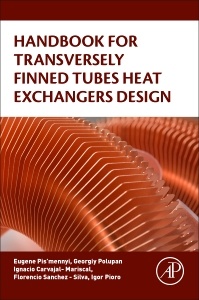Handbook for Transversely Finned Tube Heat Exchanger Design
Auteurs : Pis’mennyi Eugene, Polupan Georgiy, Carvajal-Mariscal Ignacio, Sanchez-Silva Florencio, Pioro Igor

Handbook for Transversely Finned Tubes Heat Exchangers Design contains detailed experimental data, correlations, and design methods for designing and improving the performance of finned tube heat exchangers. It covers the three main types, circular finned, square finned, and helical finned tube bundles.
Based on extensive experimental studies and tested at leading design and research institutions, this handbook provides an extensive set of materials for calculating and designing convective surfaces from transversely finned tubes, with a particular emphasis on power plant applications.
1 GENERAL STATEMENTS
2 HEAT TRANSFER CALCULATION
2.1 Basic Equations
2.2 Overall Heat Transfer Coefficient
2.3 Reduced Heat Transfer Coefficient
2.4 Convective Heat Transfer Coefficient
2.5 Coefficient of Heat Transfer from the Wall to the Internal Medium
2.6 Contamination Factor and Thermal Efficiency
2.7 Average Temperature Difference
3 CALCULATION OF AERODYNAMIC RESISTANCE
4 CALCULATION OF HYDRAULIC RESISTANCE
5 CALCULATION OF TEMPERATURE MODE OF FINNED TUBES
6 STRENGTH DESIGN
7 EXAMPLES OF CALCULATIONS
design engineers, researchers, and students of power engineering and power machine construction specialties
Georgiy Polupan graduated as a mechanical engineer within the area of steam generator design from the National Technical University of Ukraine, Kyiv Polytechnic Institute. He obtained his Ph.D. within the area of thermal physics at the same institution.
His major area of study is thermal processes in steam generators, thermo physics, and efficient use of energy. He is an author of more than 300 publications, including three technical books, two patents, and 67 papers in refereed journals.
G. Polupan was a researcher at the Thermal Physics Department from 1972 to 1985 and a professor of the Thermal Engineering Faculty of the National Technical University of Ukraine, Kyiv Polytechnic Institute from 1985 to 1999. Since 1999, he has been a full professor at the National Polytechnic Institute of Mexico, Superior School of Mechanical and Electrical Engineering, Thermal Engineering and Applied Hydraulic Laboratory.
Ignacio Carvajal-Mariscal graduated as a Mechanical Engineer from the Moscow Power Engineering I
- Provides a design manual for calculating heat transfer and aerodynamic resistance of convective heating surfaces fabricated in the form of tube bundles with transverse circular, square and helical fins
- Presents calculations for finned surfaces operating under conditions of clean and dust-laden flows alike, including finned convective heating surfaces of boilers
- Includes a fully solved exercise at the end of the book, illustrating the top-down approach specially oriented to power plant heat exchangers
Date de parution : 05-2016
Ouvrage de 188 p.
15.2x22.8 cm
Thèmes de Handbook for Transversely Finned Tube Heat Exchanger Design :
Mots-clés :
Aerodynamic resistance; Allowable; Arrangement of finned tubes; Collectors; Convective; Design pressure; Design temperature; Fin base; Fin tip; Finned tube; Finned tubes; Friction resistance; heating surfaces; Heat-transfer coefficient; Heat-transfer medium; Heat-transfer surface; Hydraulic resistance; In-line arrangement; In-line bundles; Internal medium; Maldistributed tubes; Medium enthalpy; Monophase flow; Nomogram; Nomograms; Prandtl number; Resistance coefficient; Reynolds number; Solid fuels; Staggered arrangement; Staggered bundles; Strength design; stress; Tube bundles; Tube elements; Tube spacing; Turbo-refrigerating unit (TRU)Water-to-air heat exchanger (WAHE)Two-phase flows; Wall thickness



